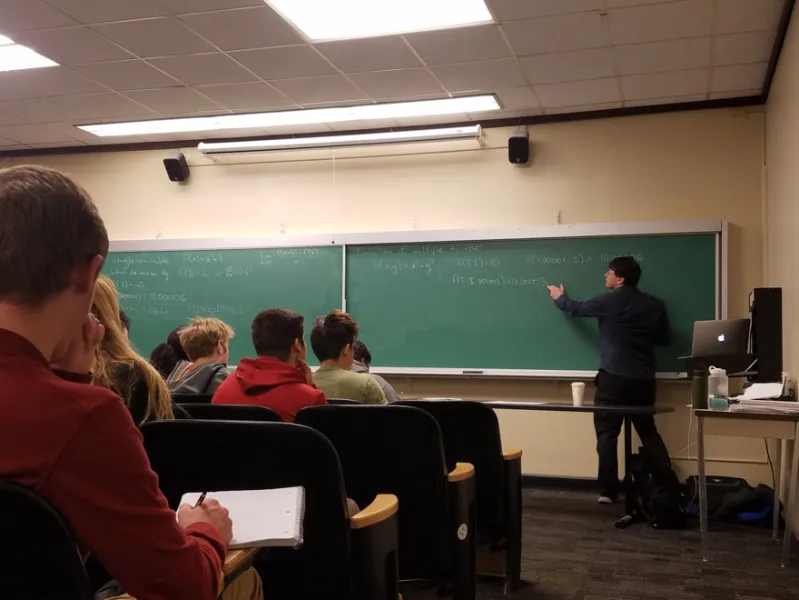Last fall, the Stanford Mathematics Department introduced a new course titled MATH 18: “Foundations for Calculus.” The addition was a major step in the department’s ongoing efforts to make its curriculum more accessible to students from various math backgrounds, and the department plans to expand MATH 18 and similar resources next year as students have reported positive outcomes.
Some students without a robust math background expressed apprehension about pursuing quantitative studies at Stanford prior to the introduction of MATH 18, math major Emily Dickey ’23 said. Quantitative studies are academic disciplines that use mathematical analysis to understand the world, including social sciences, natural sciences and engineering.
Dickey, who has previously written for The Daily’s sports section, said that “having a strong foundation in whatever classes you have taken previously will be helpful, because math builds on itself.” She added that for students without this strong foundation, pursuing a quantitative degree was possible but involved unique challenges and required careful planning.
Last year, Stanford revised the wording of its high school math curriculum recommendations to emphasize conventional math classes. The change represents a growing sentiment among education professionals that foundational courses such as algebra, geometry and trigonometry are essential to success in college-level work.
Mathematics and computer science student Benjamin Yan ’24 said that math is an integral part of many academic disciplines, and that an incoming student’s high school math experience should not be a barrier to success.
“There are plenty of understandable situations why a student might not take as much math as another student,” Yan said. “Any college just wants a student who is motivated and eager to learn, and at the end of the day, those general passions are going to outweigh any specific knowledge you might have had heading into Stanford.”
Mathematics professor and Director of Undergraduate Studies Brian Conrad said that the math department created MATH 18 in an effort to make its curriculum more accessible following feedback from students that existing resources were not sufficient math preparation for people at all levels. According to the course description for MATH 18, “A primary goal is to help students to hone the mathematical skills necessary to transition to quantitative coursework at Stanford, including how to use understanding of ideas to improve study habits and to avoid excessive rote memorization.”
Conrad said that Stanford has a pedagogical philosophy behind its introductory math courses that fosters deep understanding of concepts.
“Helping students to realize that you can actually understand things and that things in math come from somewhere makes their ability to use the material so much larger than what it was before,” Conrad said, adding that the department’s decisions to further develop MATH 18 are based on data which showed that students who took the course performed better in later introductory math courses than their peers with comparable placement diagnostic scores.
Symbolic Systems major Beatriz Stix-Brunell ’25 completed MATH 18 last fall. Stix-Brunell is a non-traditional student who arrived at Stanford at age 28 after dancing professionally with The Royal Ballet in London for over a decade.
“When MATH 18 first came out, I was very excited because I felt it was geared especially towards someone like me, who had really needed to brush up on foundational math skills,” Stix-Brunell said. She said that MATH 18 has provided her with a great confidence boost and a strong mathematical foundation due to the supportive professors and thorough teaching style.
“I have felt very welcome in math, and that is a really nice feeling,” Stix-Brunell said.
Due to this year’s success, Conrad said, MATH 18 is expected to attract more students and open more class sections next year.
The advisory diagnostic placement exam that students take prior to enrolling in their first math course at Stanford is one factor that influences course enrollment. Christine Taylor, a mathematics professor who oversees the math diagnostic tests, said that the diagnostic results in previous years did not explicitly recommend MATH 18 to students. Instead, previous diagnostic results included the following note: “If your score given below for Precalculus topics is less than 20 then we strongly urge you to consider enrolling in Math 18.”
Starting next year, students in a certain score range will be directly advised: “Based on your responses, we recommend that you enroll in Math 18.”
The change is only one step in a larger movement to build academic support systems within the math department and enrich the introductory curriculum. Taylor said that students “should not feel rushed to skip ahead,” emphasizing that the “mathematical maturity” students gain from introductory-level calculus courses is crucial for future success.
Taylor added that students with questions about math are encouraged to reach out to professors or consult the department’s many other resources, including the online refresher courses, the Stanford Online Academic Resources (SOAR) Mathematics Program and Stanford University Mathematical Organization (SUMO).
Conrad said that Stanford makes an institutional commitment to guarantee that all admitted students can access all majors. While the University is still facing challenges, the math department’s recent efforts are one example of work towards making this promise a reality.
This article has been corrected to include the correct course title for MATH 18. The Daily regrets this error.
